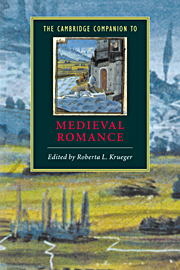Book contents
- Frontmatter
- Introduction
- Part 1 The origins, forms, and contexts of medieval romance
- 1 The shape of romance in medieval France
- 2 Marvels of translation and crises of transition in the romances of Antiquity
- 3 Romance and other genres
- 4 The manuscript context of medieval romance
- Part 2 European romance and medieval society
- Part 3 European transformations
- Editions and translations
- Index
- Series list
3 - Romance and other genres
from Part 1 - The origins, forms, and contexts of medieval romance
Published online by Cambridge University Press: 28 May 2006
- Frontmatter
- Introduction
- Part 1 The origins, forms, and contexts of medieval romance
- 1 The shape of romance in medieval France
- 2 Marvels of translation and crises of transition in the romances of Antiquity
- 3 Romance and other genres
- 4 The manuscript context of medieval romance
- Part 2 European romance and medieval society
- Part 3 European transformations
- Editions and translations
- Index
- Series list
Summary
In the opening lines of Guillaume de Dole (c. 1209-1228), Jean Renart claims that his text is both a romans (lines 1 and 11) and “une novele chose” (“a new thing”) because he interpolates lyric stanzas into his narrative (13-14). He thereby simultaneously signals continuity and change. He writes a romance, but self-consciously produces something different from previous romances. He plays on the parameters of two textual traditions (romance and lyric), but in incorporating one type of text into another he troubles these parameters as he evokes them: he gives the stasis with which lyric frames desire a forwards (narrative) movement and he injects a startling formal and temporal rupture into his romance since the lyrics necessarily halt the action temporarily. Guillaume de Dole is thus a romance that contests the generic framework to which it belongs. Furthermore, even the term Jean uses to designate the genre he seeks to change - romans - is problematic. Roman derives from the expression metre en roman, “to translate into the vernacular,” and initially means simply a narrative translated from Latin. If some writers use the term in a manner that suggests a distinct category of text that we call romance, roman is not infrequently used to describe texts that we think of as belonging to other genres, while some 'romances' are called contes by authors or rubricators. Thus if the genre is unstable, so is the terminology used to designate it.
- Type
- Chapter
- Information
- The Cambridge Companion to Medieval Romance , pp. 45 - 59Publisher: Cambridge University PressPrint publication year: 2000
- 5
- Cited by



